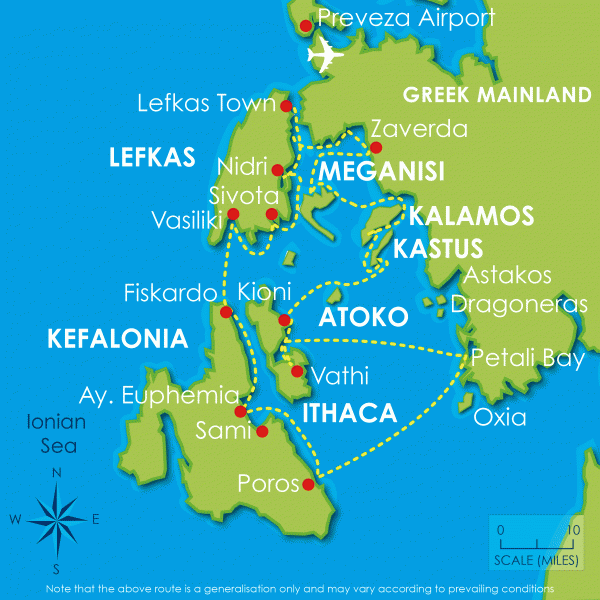
South Ionian Islands
”Greek Yacht Charter Ionian”
Pristine Yachting helps you plan your once-in-a-lifetime, dream sailing holidays with a yacht charter in the South Ionian Islands, Greece! A cluster of islands in the most western part of mainland Greece, the Ionian Islands contain a collection of some of the Mediterranean’s most famous and popular yacht charter sailing destinations, bringing a wonderful blend of fun, relaxation and different Greek island culture, landscape and experiences. You can charter your dream sailing yacht here from either Corfu in the North or Lefkas (Lefkada), Preveza and Kefalonia in the South, with three main airports.
The South Ionian islands, which include the likes of Kefalonia and Lefkas, reside within a large, inland sea enclosing as many as over twenty islands such as Meganissi, Kastos, Kalamos, and the legendary Ithaca (think ‘the tales of Odysseus’). Explore these sensational, dramatic islands by yacht and discover a magnificent array of memorable, postcard-worthy bays and anchorages with gorgeous beaches, caves and white cliffs, surrounded by olive groves and cypress trees.
Places To Visit: South Ionian Islands, greece
Ready to start planning?
The Different Ways To Yacht charter
What Marinas can I depart from?
Suggested Route: Map
Sailing Conditions & Weather
For the most part, the wind and weather conditions in the popular sailing months are favourable; however, the Ionian Sea is impacted by the north and northwestern prevailing winds. These are most prominent from mid-afternoon to sunset and can mean strong crosswinds and gusts funnelling over the mountainous landscapes. Planning and a thorough understanding of the weather forecasts are recommended, and don’t be afraid to ask your charter operator, fellow sailors or locals for top tips. As is the case in most of Greece, you’ll often be required to moor against the quay or the shore with the anchor and long lines.
.
You must plan your technique according to the wind, and all crew members understand their role. Prepare long lines, have them coiled ready and if you can holla down assistance ashore, don’t be afraid to ask. If not, send a crew out by dinghy to prepare the lines to shore first, and have the dinghy crew meet the yacht after she drops anchor and goes astern. A large amount of chain is usually required due to the land's topography being quite steep (shifting from shallow to too deep very quickly).
An NW wind is the dominant weather pattern throughout the Ionian sea, the maestro. Typically, however, this wind is less intense, with a Beaufort scale force of 2 to 5. Compared to the infamous Meltemi over in the Aegean and Cyclades, much less caution is required. Having said this, you must remain wary of the gusts when cruising on the lee side of hilly islands and be conscious there might be katabatic winds from the NE in the evenings, Force 5-6 from the mainland mountains.
Starting in October up to mid-May, the wind usually from the S to SE can produce gales, and it’s possible to encounter waterspouts. Typically detected on the radar to help you steer clear, it’s a good idea to keep a visual for these – they can be easily seen in good light. You may also encounter regular thunderstorms and squalls, with Corfu recording the highest rainfalls throughout Greece.
Sources for weather information:
Athens Observatory gives three days (every 6 hrs) detailed graphical forecasts for the Greek seas.
Poseidon System gives three-day forecasts for Greek seas from the National Center for Marine Research (Not very reliable).
Weather on Line provides detailed seven-day forecast charts for the Mediterranean, Northern Europe and the Atlantic.
Greek Meteorological Service (EMY); Navtex weather bulletins.
Wind Guru is a surfer’s site with worldwide wind forecasts.
Ready to start planning?
Essential Travel Information: Greece
Currency: Euro (EUR)
Language: Greek
International Dialling Code: +30
Visa requirements: Citizens of the EU, US, Canada, Australia, and New Zealand do not need a visa to visit Greece for stays of up to 90 days.
Best time to visit: The best time to visit Greece depends on what you want to see and do. The peak tourist season is June to August, when the weather is hottest, and the beaches are busiest. May and September shoulder seasons have more moderate temperatures and fewer tourists.
Weather: Greece has a Mediterranean climate, with hot summers and mild winters. In summer, temperatures can reach up to 40 °C (104 °F) on the mainland and 30 °C (86 °F) on the islands.
Health and Safety: Greece is generally considered safe, but visitors should be aware of the risk of pickpocketing and theft in tourist areas. Be sure to keep your personal belongings safe and secure at all times.
Transportation: Greece has an excellent public transportation system, including buses, trains, and ferries. Taxis are also readily available.
Food and drink: Greek cuisine is known for its healthy and delicious food, including dishes such as moussaka, dolmades, and souvlaki. Greek wine and ouzo are popular drinks.
Tips and Customs: Tipping is not mandatory, but it is customary to leave a small tip (5-10%) in restaurants and cafes. In Greece, it is considered impolite to leave food on your plate, and it is also customary to dress modestly when visiting religious sites.
Tourist Attractions: Some of the most popular tourist attractions in Greece include the Acropolis and the Parthenon in Athens, the island of Santorini, the ancient city of Delphi, and the Palace of Knossos in Crete.
Worldwide Charter Destinations
Why Choose Pristine Yachting?












































